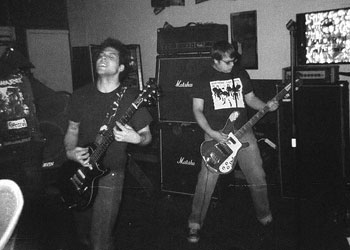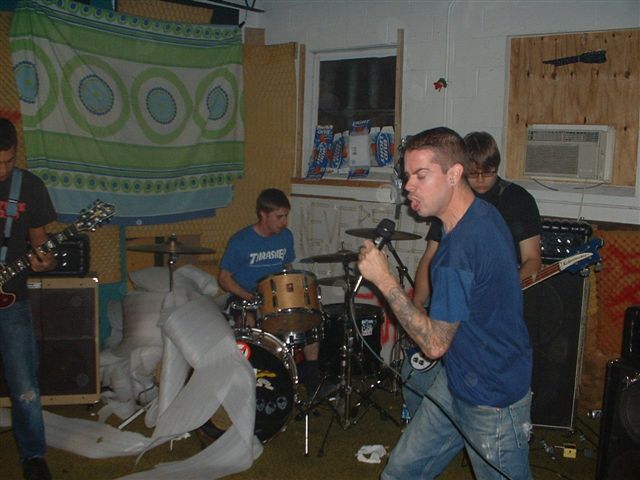Mike Alexander, Urban Planner and Rock Guitarist Extraordinaire

I’m interested in what people do for a living. Why? Because what we do for wage takes up most of our lives, and whether we hate it or love it, it has the biggest impact on our short time on this planet. I’m also pretty damn interested in people who’s jobs have impact on loads of other people’s lives. Mike Alexander is an urban planner, and so his job affects a lot of other people. I’ll let him explain.
My professional career began working for a midsized suburb in West Central Florida as an Urban Planner during the end of the boom period of commercial and residential real estate development from 2006 to 2008 (before moving to Sweden to continue my education). During this time I was responsible for ensuring that real estate site plans complied with city and state codes of development.
Upon returning to the United States in early 2011 I was fortunate enough to return to Cleveland, Ohio accepting an appointed position with the reformed Cuyahoga County government as a Board of Revision Hearing Officer. My duties include hearing complaints from taxpayers and other interested parties and determining fair market value of properties, which have experienced, for the most part, extreme devaluation in recent years due to the foreclosure crisis and lack of available credit for investment. The fair market value of properties is the value upon which the effective tax rate is applied to fund municipal and county services.
To start, just so you know I’ve written these questions largely drunk on a plane. Also this interview is largely motivated by a hatred for the industry of which I claim as my own, namely design. Any questions?
No.
Could you say that you are designing the city in a way?
As a Hearing Officer, The short answer is: No.
As a public sector Urban Planner, the short answer is: To some extent.
As a Hearing Officer, I assign value that is a mirror of the market. What properties would probably sell for on a given date in time? This value is, like I mentioned previously, the value, which the rate is applied to and the amount of tax the taxpayer is responsible for is based upon.
As a City Planner, I do feel that my role is to not only ensure compliance with regulations, but also to engage the community and utilize their input to make plans and design that the community supports while leading them through the process with my own skills and knowledge of the field.
The developers, architects and engineers are the real creators in the market, but they have to at least adhere to a minimum standard determined by the community that has to live next to the product (in theory).
Does design or any higher concepts of an urban plan have any real affect on real places like Cleveland?
Design can and does have an impact on communities all over the City and region but more on the micro level. Very simple design elements such as landscaping, building setbacks, parking requirements and placement, as well as walkability absolutely have an impact on people’s desire to visit and explore (work, live, play) a given environment.
Even anti-skating guards on benches and near buildings can make a place more desirable…sorry Jim, this tends to keep the riff raff away. [Editors note: He’s completely wrong about this]
But the more long term overall picture is dictated by policy and ultimately demand for places. This is exampled by investment in infrastructure (which will need good design to be affective long term) and encouraging a diverse job creation and retention plan for the region. (I could elaborate forever on this issue…regionalism, tax incentive programs, catalytic institutions, etc.)
What do you think of loads of cities trying these grand schemes? I remember Cleveland trying to do this Design District where “young independent designers” would sell furniture. They neglected the bit about there not being any other reason for the rich people who would buy this furniture to go there. Why do they always do this sort of thing?
It’s one thing to have a good idea, and another to try to implement it without the proper market analysis. To just create an arts district or design district, or any other type of district, with the “build it and they will come” approach could be disastrous. There has to be the right mix of location, consumer, and/or subsidy to make any project successful. A catalytic institution is also very helpful in a situation like this (i.e. capital theatre, beach land ballroom and tavern). The hope on the part of the City is to use this district as a catalyst that will lead to other spin off development. This is a bit of a gamble with taxpayer dollars, but with the right analysis the project can be successful.
The thing I think about urban planning is its generally quite loose in practice. When you give an architect or designer a brief to redesign a place it’s usually to make massive changes and do stuff that the people there won’t really give a shit about, like public art. Urban planners seem to be more realistic. Tell me how
Urban planning is more functional and practical mostly because its purpose is to control space and make it user friendly. Whether the user is young, old, pedestrian or motorist space firstly must functionally flow. Art and other design factors are second in most cases.
After traveling to both Sweden and China in recent years I have seen good (and bad) examples of plans implemented. The planner should be designing spaces for current and future users, but in many cases funding and/or demand can have a negative impact on the projects aesthetic outcome. Because of Sweden’s climate newer developments focus less on exterior design elements and more on interior design. Therefore, some developments, such as those constructed during the million dwelling program of the 1960’s and 1970’s have some emphasis on landscaping and commonplace amenities, however they were minimal. This made the dwellings very undesirable and since conception these developments have added more art and color to make the spaces more attractive.
Chinese urban planning, in my opinion, is much different due to cultural and political differences. Many squares and other public places have very modern fountains and incorporate public art as well, but can be viewed as very cold places by some foreigners. Additionally, developments are popping up so rapidly in China that the plans can never really meet the demand. A current problem China faces is related transportation planning, in that, the buildings are becoming so densely developed that it is causing issues with cars parking on sidewalks and people walking in the streets. This is also caused, in large part, by the rising middle class and the affordability of automobiles in recent years. Plans try, but just can’t keep up with the future demand.
On the other hand, China is slowly realizing the need to preserve historical sites. This epiphany is mostly designed to retain tourist revenue, but nonetheless these older districts are some of the most attractive and functional spaces in the country, in my experiences.
Tell me, you lived and studied in Stockholm and are now working for the Man in the Rustbelt. Does Cleveland really have a chance in hell?
The short answer is: Maybe.
While things currently look bleak in Cleveland due to the foreclosure crisis this can also be viewed as a potential opportunity to breed creativity and investment. Because Cleveland is so affordable now it has become very attractive to many artists and designers and that could be a very positive thing for the City and region. With the right leadership to guide development and investments the area can once again be in demand. While I strongly believe this can happen, I must stress that the right leadership must be in place to achieve even the most modest of goals that the citizens demand before the disinvestment becomes too great to overcome.
What do you think about Detroit in the context of the Rustbelt? I mean it’s somehow become the darling of Wired and whoever else as this post-industrial wasteland that is now one massive electronic art love fest or something. What’s the reality for places like Detroit, Milwaukee or Cleveland?
Detroit and Cleveland have very similar problems, obstacles to overcome as well as opportunities. Detroit just has these problems on a more grand scale. Like I mentioned previously, the fact that the market is so depressed in these cities it does have the potential for reinvestment and allow opportunities for young people. Some see Cleveland or other ‘rustbelt’ cities as places of affordability and opportunity because they are not as expensive as their East coast or West coast counterparts (i.e. New York, Boston, SF, Portland). This is the hope that these cities can have. Along with a catalytic center and good leadership that understands this niche these cities can have, to start at least, thriving pockets of activity and investment.

Can good music come out of a good place to live. I say no. Thoughts?
This question can be viewed as subjective. What is ‘good music’? However, in my opinion and my own taste in music, I find that there are creative people in urban, suburban, and rural as well as wealthy and poor areas that can produce music that will connect with people and rock pretty hard too.
I think socialist countries like Norway or Sweden are examples of places where they have a very sustainable and modest lifestyle and they have been producing popular groups for many years from a different, but relatable perspective to other parts of the western world. But I think that a city like Cleveland that has a kind of ‘down and out’ mentality is keeping many of its artists ‘in the shadows’, at least for now. If things begin to turn around in the future, we will see.
I think that in places like Cleveland musicians and artists may put all of their focus on ‘making it’, but in these cases the current economic constraints may stop them from achieving these goals, because they are working to keep food on the table and putting their art on the back burner. When the economic conditions improve enough to multitask these artists are able to really reach out and get their art out there.
